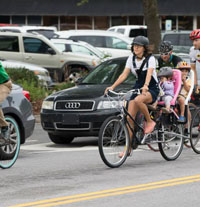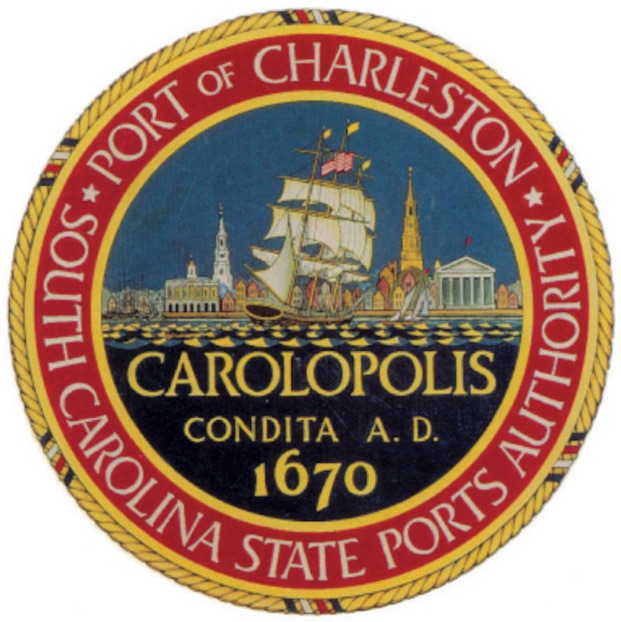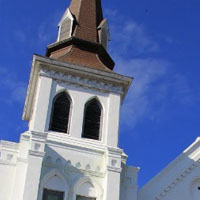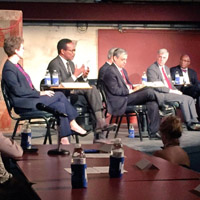


This week’s blog post features another in our series of interviews with Charleston’s movers and shakers who are working to make Charleston more livable for everyone. We celebrate Kurt Cavanaugh’s one-year anniversary as the first full-time Executive Director of Charleston Moves, and applaud his efforts at getting the message out to make our roads, sidewalks, and paths safer (and therefore more enjoyable) for bicycling and walking.
Kurt, tell us about your organization’s mission and how that relates to the concept of livability in Charleston?
Charleston Moves advocates for safer streets for people who walk and ride a bicycle in Charleston County. We are a nonprofit organization that began in the 1990s as the Charleston Bicycle Advocacy Group (CBAG). We all have C-BAG (said like, “sea-bag“) to thank for ensuring that the replacement bridge over the Cooper River, the Ravenel Bridge, included access for people, not just vehicles. The result, Wonders’ Way, is arguably the best route to bike and walk in the entire state.
As an organization, we want to share what we have discovered – that Charleston’s beauty is best enjoyed on the seat of a bicycle or on your feet. Wherever you go, our work aims to make your bike ride or walk safer and more convenient. Charleston Moves is not about bikes as much as it is about building and enhancing a safe, connected, livable, lovable community.
Now, for the hard question . . . if YOU were mayor, what would you do?
My first effort if I were Mayor of Charleston, would be implementation of the approved bike and pedestrian lane on the Legare Bridge in cooperation with Charleston County, the entity in charge of funding, designing, and installation of the lane. This lane will be a linear parkway by virtue of extending the West Ashley Greenway and connecting with the waterfront walk around the peninsula. It really is the linchpin for safe, convenient access between West Ashley and the peninsula. Coupled with basic intersection improvements to bring cars and bikes safely downtown, it is also an example of smart, “people first” planning for our entire region, and offers downtown and West Ashley residents another viable transportation option for work and play.
Your organization focusses on walking as well. Any particular efforts you would, as mayor, put in place to make walking a safer and more pleasant experience?
Visitors drive hundreds of miles (and spend millions of dollars) to walk around our historic district. To better serve locals and visitors alike, I would implement and enforce a blanket 20 MPH speed limit to limit the possibility of unwarranted deaths and injuries. At intersections with lots of pedestrians (Calhoun & East Bay, Market & East Bay, Market & Meeting, King & Calhoun, Hwy 17 in Avondale, Windemere), I would have No-Right-on-Red restrictions. To keep things moving we would also consider traffic signals that feature what is called Lead Pedestrian Intervals (LPI). These give people walking a slight head-start, normally 3 – 7 seconds, before motorists are given a green light.
Speaking of people who walk, College of Charleston students take over both Coming Street and St. Philip when school is in session. That’s great. Let’s help them get around safely by installing diagonal crossings at St. Philip & Calhoun and Coming & Calhoun. To quote Gabe Klein, former transportation commissioner of DC and Chicago, these intersections are “ideal candidates for a “Barnes Dance”, or modified all-red signal pattern. This would allow pedestrians to cross in all directions including diagonally and flush the intersection so that cars don’t conflict as much.”
In South Carolina, drivers must yield to pedestrians in crosswalks. I would install yield signage IN THE CROSSWALK at strategic locations (MUSC campus on Ashley & Rutledge, CofC on Coming and St. Philip, in Avondale, in Windermere, and near attractions such as libraries, schools, parks, playgrounds, bus stops, and places of worship) since studies show that people pay more attention and are more likely to comply with these laws when these simple signs are present.
Could you tell us a bit more about the comprehensive efforts to make riding bicycles a more integrated part of our transportation system?
In March, Charleston Moves and the City’s Design Division asked residents where they bike on the peninsula. The routes submitted on PeoplePedalCharleston.com formed the initial step in the development of the City’s upcoming Downtown Bike Plan. The City’s goal of 1,000 routes was blown out of the water. 1,303 people submitted 1,738 routes! Almost 20% of the routes came from West Ashley.
If I were Mayor, I would quickly install the recommendations that are outlined in the City’s Downtown Bike Plan. The best thing about the Plan (I’ve seen the draft) is that it is immediately doable. Most of the projects can be implemented quickly, and for pennies on the dollar, with just paint, signage, and traffic signal tweaks. May the days of “Share The Road Signs & Hope For The Best” be gone!
Finally, I would repeal the rather draconian bike parking ban on King Street. Bicycles should not be confiscated if they’re locked to meters or signposts. Parked bicycles are not a pedestrian safety hazard. Charleston is a city, not a movie set, and people riding bikes should thanked, not punished.
Thanks, Kurt, for your insights and efforts to make Charleston Moves such a big part of what makes Charleston special. Keep in touch with Charleston Moves here and on Facebook here. Charleston Moves is always (!) busy and membership has its advantages. You can count on Bike Month during May each year having some great events, including safe cycling workshops, Bike to Work Day, and the Ride of Silence. Everyone, regardless of skill or age, is invited to the sixth annual RIDEdwin coming up on Saturday, July 18,. The 3.5 mile fun bike ride around Charleston begins at 9 am at Cannon Park. Coming in October is the New Belgium Clips Beer and Film Tour.
At IfYouWereMayor.com we believe that the first step to tackling the region’s transportation problem is recognition that our water-logged geography limits the extent to which road building can address the full extent of our transportation needs. Our existing infrastructure must be tweaked to accommodate a whole host of ways of getting to and fro – foot, car, bus, bicycle, boat, train – before we can throw more limited resources at building ring roads that really can’t do the job on their own.

We applaud the Ports Authority for their $5 million investment to be used for the purchase and protection of land along the Cooper River watershed to mitigate the potential effects of deepening Charleston Harbor. The agreement, made earlier this year, was reached in collaboration with the Lowcountry Open Land Trust, the Coastal Conservation League, and the Southern Environmental Law Center. This type of cooperative work can make our city and port even better.
SOME HISTORICAL BACKGROUND
The port has existed here for virtually as long as the settlement of Charleston. Today, the port consists of five public marine terminals and is owned and operated by the South Carolina Ports Authority (SCPA), a self-governing entity created by the South Carolina General Assembly in 1942, with board members appointed by the state’s Governor and confirmed by the State Senate.
The historical significance of the port is illustrated by Charleston’s colorful maritime history, with many of the city’s earliest historic structures having been constructed as businesses associated with port operations – cooperages (barrels are the original “containers”), smithies, stevedoring companies, warehouses, etc. The city’s historic waterfront, now a public promenade and park, was once marked by numerous wharfs, hundreds of masts of sailing vessels, shipbuilding, and provisioning operations. If other myths hold any truth, numerous of the city’s earliest streets and walks were constructed from ballast recycled from ships loaded with items destined for global destinations, including indigo, rice, and cotton.
This early Charleston invited people of many backgrounds, often unwelcome in other parts of the world, who found their way here for economic opportunities – French, Scottish, Irish, and German, as well as Jews and Catholics. Sephardic Jews (of Spanish and Portugese ancestry) migrated to the city in such numbers that Charleston became one of the largest Jewish communities in North America (see maritimeheritage.org). From the late 18th through the 19th century Charleston also served as the most active port in the trade of slaves in America, and many Africans, free and slave, lived here outnumbering white residents by a long shot. (see this animated map illustrating the slave trade that is generated from data at slavevoyages.org).
THE PRESENT
Today, the port’s focus is the movement of containerized shipments and passenger vehicles; and, it consistently ranks in the top 5 of the nation’s containerized ports. Jobs at the port have long been a fundamental source of well-paying, stable jobs in the Charleston region as evidenced by the success represented by the members of such organizations as the International Longshoremen’s Association and the Charleston Branch Pilots Association. Basically, its operations employ “hundreds of thousands” and generate “in excess of $45 billion per year” in economic impacts.
The port’s mission, as one would expect, is largely focused on the bottom-line, especially as it faces fierce competition from other nearby ports in Savannah and Jacksonville:
“The South Carolina Ports Authority (SCPA) promotes, develops, and facilitates waterborne commerce to meet the current and future needs of its customers, and for the economic benefit of the citizens and businesses of South Carolina. The SCPA fulfills this mission by delivering cost competitive facilities and services, collaborating with customers and stakeholders, and sustaining its financial self-sufficiency.”
Sometimes, adherence to this mission runs up against the interests of many who live in proximity to port facilities. The Port Authority has made many efforts to be responsive to local concerns, but with growth in cruise ship traffic in recent years, the local population has increasingly questioned the port’s intentions and its future. Port officials point to their efforts at downtown’s Union Pier to modernize the passenger terminal facilities, including development of parking facilities and completing road connectivity in the vicinity, to mitigate impacts of the embarkation of cruise ships. The community calls for more controls, including the use of shore power when in port and limitations on the number of cruise ship visits during the course of the year. The port recognizes that cultivating and fostering the community is key to the success of its cruise business. However, at this stage, the back-and-forth has mired everyone in lawsuits and there is frustration on all sides.
AN EXAMPLE FROM ABROAD
A year ago, I traveled to Amsterdam with my daughter and visited the National Maritime Museum of the Netherlands, Het Scheepvaartmuseum. Recognizing that Rotterdam was the largest container port outside of China, I was curious how this museum portrayed this vital industry through their history and how they reconciled this history with the future. The historic exhibits were fascinating – the Dutch essentially invented the concept of container transport – and, in one instance, frightening. Slave Trade: The Dark Chapter (see NYTimes review here), underscored that trade’s horrors through installations focused on the slave ship Leusden which sank in Suriname, South America, in 1738. After the ship ran aground, the ship’s captain ordered the “cargo” to be secured in the hold to ensure the investors received an insurance settlement for the loss, and almost 700 African men, women, and children drowned. If there was one thing you could take away from the exhibit, the Dutch do not shirk the dark side of their shipping history.
The final exhibit in the museum, a film projection, took visitors on to the docks and aboard ship from the point of view of a container, and focused on aspects of shipping that Rotterdam uses to distinguish its competitive edge: efficiency, safety, and sustainability.
This seems an interesting triumvirate to success, and is reflected in the port’s strategic plan, Port Compass 2030 (a synopsis in English is here). This document, developed in cooperation with the municipal government, port business association, provincial government, and national government, focuses on ten priorities ranging from infrastructure development to cultivating education geared towards employment. An annual report keeps all stakeholders informed as to the progress (or lack of progress) in each category.
Digging a bit more, one finds a somewhat different mission statement than that of the SCPA: “The Port of Rotterdam Authority develops, in partnership, the world-class European port.” The port’s website corroborates the exhibit’s message: “We continuously improve the Port of Rotterdam, to make it the most efficient, safe, and sustainable port in the world…”
THE FUTURE
Theirs may seem a rather basic inconclusive mission, but there is also a distinction in Rotterdam’s governance that might be a more significant clue to how Charleston’s port might consider serving the community interests along with those commercial goals of the state: “The Port of Rotterdam Authority is an autonomous company with two shareholders, the municipality of Rotterdam and the Dutch state.”
Could the South Carolina Ports Authority in Charleston benefit from a Board of Directors that includes representatives who serve at the behest of the communities most impacted by the port operations? A thriving Charleston benefits most from a thriving, economically viable port relationship. It might be time to consider more ways to deepen the ties that bind us to our historic port, cultivate more ways to foster the resources that we share, and find economic opportunities that can create a competitive edge that is distinctive and adds value for the port’s customers.

If You Were Mayor awoke on Thursday morning to the crushing news that a lone gunman entered the historic ‘Mother’ Emmanuel AME Church in Charleston, South Carolina, and sat with the congregants for an hour of their Wednesday evening prayer service before he raised a gun and killed nine individuals, including the pastor. The evidence suggests beyond all doubt that the event was a hate crime, perpetrated by a young white man against a group of African American church members gathered in solace and peace. Through the diligence of local, state and federal law enforcement, the suspect was apprehended Thursday morning in North Carolina.
The resulting outpouring of love and support from the community of Charleston for the families and their church has been nothing short of awe-inspiring. During a Thursday morning press conference Mayor Joe Riley was visibly angered by the episode and expressed commitment to supporting the victims and their families, noting that the city had established a fund to receive donations and seeded it with $5,000. A tearful Governor Nikki Haley spoke of the “time to heal.” A prayer service honoring the victims was held at nearby Morris Brown AME Church. One speaker referred to how “colorful” the crowd was, and another indicated that we must now “put the devil out of business” and “seek the power in love.”
A strong sense of community is critical during any crisis, and this crime has underscored the need to cultivate and maintain those ties that bind us together. Substantial growth, divisive discourse on everything from education to justice, and under-resourced infrastructure undermine our ability to make the decisions necessary to create a strong sense of community and purpose within our region. The third annual Tri-County Housing Summit, hosted by the South Carolina Community Loan Fund (SCCLF), on Friday, June 12, gathered a wide spectrum of stakeholders to discuss efforts to address some of these concerns.
The gathering put some perspective on why the long-term economic viability of the region is tied to housing affordability. This is especially the case given the area’s dubious distinction recently as one of seven overvalued housing markets in the country according to the real estate analytics company CoreLogic, a real estate analytics company.
The audience was markedly diverse, and included leaders from the business community, housing industry, service providers, faith and community-based organizations, local elected and governmental officials, federal and state officials, and other interested, engaged individuals. Everyone came prepared to interact and focus their collective energy on how public policy strategies could be put in place to meet the region’s growing housing and economic development needs. As the event host, Michelle Mapp, Executive Director of the SCCLF, emphasized to start things off: The question was not IF we will grow, but HOW we will grow.
During the course of the day attendees learned that the region’s population is estimated to reach one million by 2027 and that means housing for an additional 302,561 primarily single-person households. Compounding this scenario is the inadequacy of the region’s existing transportation infrastructure to handle current needs and future growth. With this fate looming large, how can the discussion be framed so it will be possible to create more compact, walkable/bikable neighborhoods and communities, as well as to develop the support for a high-quality multi-modal transit system?
The kickoff panel made the case that proximity between affordable housing and employers is paramount. Moderated by Mary Graham of the Charleston Metro Chamber of Commerce, the panel included Steve Warner of the Charleston Regional Development Alliance, realtor Lauren Newman, Business Advocacy Liaison for the Charleston Young Professionals Steering Committee, and Jon Yarian of the communications firm SeaChange. Each panelist referred to evidence that people currently cannot afford to live a reasonable distance from their workplace, therefore they are burdened by long commutes, traffic anxiety, and reduced productivity. Making matters worse, the cost of living in the area is relatively high and wages are below average compared to other metro areas in the Southeast. The call to action underscored what the Charleston region does have – the ingredients and the potential to become world-class if we can take our cues from larger, aspirational metro areas like Raleigh and Austin.
Later, a discussion between Tina Brown, Esq., of the South Carolina Fair Housing Center, and Geona Shaw Johnson of the City of Charleston Department of Housing and Community Development, highlighted some of the lesser-known and broader-based issues that relate to housing discrimination. While it was interesting to learn that the most discriminated class in housing is people with disabilities, it was the discussion of “exclusionary zoning” that captured the attention of the crowd. This development tool continues to be widely used and is a far more subtle strategy to discriminate against race, ethnicity, or even source of income, through such devices as the establishment of minimums for lot size or dwelling units.
The day’s highlight was the keynote address from Joseph Minicozzi, a principal of Urban3, LLC, a consulting company created by Asheville real estate developer Public Interest Projects. The audience was wowed by Mr. Minicozzi’s insights into the paradigm shift of thinking about development patterns. Not only did he make a case for public policies that create more dense patterns of development, he illustrated the dangers of sprawl in terms of stretching public resources to the breaking point.
Mr. Minicozzi is a compelling speaker and he has developed a sophisticated mapping toolkit that can legibly illustrate to officials and residents alike how we can better allocate our resources and generate sustainable revenue streams. In practice, compact development can provide for less stress on our roads and bridges and more affordable housing opportunities.
A diverse, vibrant community is full of opportunities and shared stories. In Charleston, we have been shaken by recent deaths within the African American community. It is vital for us to remember that we all share a history and legacy that can build a stronger, more livable community for all. We can build housing, jobs, and our future, if we draw upon the strength we have in working together. Our next generation of leaders must recognize this.

If you missed it, Tuesday’s Arts Matter Mayoral Summit was attended by approximately 200 people. The room buzzed with arts leaders from many area arts organizations as well as a fair number of practicing artists. As the event unfolded, it was apparent that the overwhelming response to the role of arts and culture in Charleston from each of the candidates was positive, supportive, and constructive.
SETTING THE STAGE
To begin with, the podium was stage for candidates Ginny Deerin, Dudley Gregorie, Leon Stavrinakis, John Tecklenburg, Paul Tinkler, and Maurice Washington. Moderator Mike Gibbons of the Charleston Regional Arts Alliance introduced the panelists Keely Enright, producing director of Village Reperatory Company, and Josh Silverman, founder of Jericho, Inc., and Jericho Arts. Unfortunately, panelist James Braunreuther, Fine Arts specialist with the Charleston County School District, was unable to attend.
As expected, no candidate spoke out against the arts in Charleston. In fact, each candidate shared experiences and insights into how critical the arts are to the heart of Charleston. All recognized, not only the economic impacts related to tourism, but also the significance arts and culture play in the livability of the city for residents. The #ArtsMatter twitter feed (here) will give you an intimate view of the proceeds from the seats.
GETTING WARMED UP
The event’s kickoff question was a winner and came from Mrs. Enright: “Mayor Joe Riley has a four-decade history of supporting the arts in our community. However, a new administration brings new opportunities for supporting the arts. How will your model for the arts differ from Mayor Riley’s?”
Every candidate was quick to acknowledge Mayor Riley’s unwavering and ongoing support for the arts, ranging from large organizations like Spoleto, to neighborhood and community programs. And no candidate expressed a willingness to do less. However, the potential to encourage more diversity, both racial and geographic, brought up programs deserving of a higher profile, such as the MOJA Festival, and the possibility of expanding arts programming to other areas of the Charleston region.
COLLABORATIVE EFFORTS
The discussions through the course of the morning included a foray into “creative placemaking” and how more public art could showcase local art and artists. The discussion of what possibilities might exist for public art production to extend to other parts of the city brought up notions of both organized and “spontaneous” endeavors. Acknowledgement of area organizations such as Enough Pie and neighborhood events in areas like Avondale were notable success stories of how grassroots energy can help build and maintain support for the arts. This type of collaborative action was seen as a potential avenue to engage other leaders from neighboring communities to make a difference in art’s role in shaping the story of our region. While it was clear that art can shape the vitality of other parts of the city, maintaining an arts presence downtown was certainly on the minds of many in the audience.
FUNDING ISSUES
It is no secret that public funding of public art is also a real challenge in South Carolina and a question in this regard brought out some interesting and differing points of view. Mr. Stavrinakis pointed out that it was important to emphasize that art is not a luxury and was, in his mind, a core function of government; and, he appropriately referred to his support and advocacy, as a South Carolina legislator, of the South Carolina Arts Commission when its existence was under siege by the governor. Ms. Deerin shared the loss to our community due to the lack of a budget for original art as part of the multi-million dollar Charleston airport renovation. This is a true failure of will to recognize, as Mr. Gregorie noted, that art is the “life blood and soul of this world class city.”
AUDIENCES AND AFFORDABILITY
Opportunities for the public to engage in the arts and for artists to maintain a real livelihood from their vocations also raised issues related to funding. The importance of sustainable resources was critical and the accommodations tax provisions have been a critical piece of the overall funding of the arts community. Mr. Washington expressed concern about other types of funding sources that could be directed to affordable housing, the arts, and other community functions rather than to incentivize or finance other types of development, both public and private. Ultimately, recognition that arts and cultural events and venues are a sign of a thriving community and continuing support is vital.
At IfYouWereMayor.com we believe that some creativity may be necessary to keep some non-profit arts organizations downtown, especially in privately owned buildings, just as it holds for affordable housing. One of the most interesting processes in the country is happening in Somerville, Massachusetts – a Next City article (here) gives a fascinating picture that has many parallels to the peninsula of Charleston. Rent subsidies and tax incentives that can fill the gap between affordable and market-rate for “benevolent landlords,” inclusionary zoning, and ownership programs aimed at permanent affordability are some of the solutions and experiments that hold promise.
EDUCATION EDUCATION EDUCATION
Arts education and integrating art into the school curriculums brought up discussions about in-school and after school opportunities. Many of the candidates shared personal experiences to illustrate their support of educational opportunities. Ms. Deerin mentioned her long history with after-school programs (she founded the after-school program Wings for Kids in 1996). Mr. Tinkler and Mr. Stavranakis, both parents of former and current students in art-focussed programs in the Ashley River Creative Arts Elementary School, noted how central this is and has been in their family life. Mr. Tecklenburg shared how his love of music came from both his family and from the area’s long legacy of jazz, going back to the Jenkins Orphanage Band. Mr. Gregorie emphasized the current city council’s support of the arts, especially the legacy of African Americans in the building arts.
THE TAKEAWAY
The summit was a bright indicator that each of these successful community leaders seeking the office of Charleston’s Mayor holds a fundamental belief in the benefits that arts and culture bring to Charleston. Whether everyone in the audience was satisfied with the answers or whether more detail will be sought remains on the table. Stay tuned.
Here is the coverage from Charleston’s newspaper, the Post and Courier.

WCIV-TV | ABC News 4 – Charleston News, Sports, Weather
All six of the candidates who have publicly declared they are in the running to be Charleston’s next mayor have confirmed they will attend the Charleston Regional Alliance for the Arts 2015 Arts Matter Mayoral Summit on June 9 from 9-11 a.m. at Woolfe Street Theatre. The Summit is co-sponsored by Charleston Magazine and www.IfYouWereMayor.com.
Have an idea for the arts in Charleston? What about a project you want to see happen? Go to https://www.ifyouweremayor.com/ and share your thoughts!
Ginny Deerin, Dudley Gregorie, Leon Stavrinakis, John Tecklenburg, Paul Tinkler and Maurice Washington have confirmed they will be in attendance. They will field questions from a panel comprised of James Braunreuther (Fine Arts Coordinator for Charleston County School District); Keely Enright (Artistic Director for Woolfe Street Playhouse); and Josh Silverman (Founder and CEO of Jericho Advisors). The summit will be moderated by Mike Gibbons, Executive Director for the Charleston Regional Alliance for the Arts.
The event is free and open to the public. The Summit will conclude with a question and answer session with the audience.